Whether you are working in-house at an enterprise company or you’re an agency working with enterprise clients, you’ll find that navigating the corporate landscape is complex. You may know exactly what the company needs to do in order to be successful, but actually getting things done can be a challenge.
One person’s challenge is another person’s opportunity. Being able to cut through red tape and get things implemented is a super power. Here are challenges you’ll need to overcome to be successful in the world of enterprise SEO.
Complex team structures and infrastructure
Enterprise companies are simply harder to work in than other companies. They’re big and complex organizations with a lot of moving parts and rules.
Teams
Enterprise companies have a lot of people on many different teams. Finding the people on different teams who you can collaborate with can be a challenge. Try to leverage the institutional knowledge of others who have been around for a while to help guide you.
Even an SEO team may be fractured, at least for less mature organizations. Eventually you usually see consolidation in the efforts and core teams being established, but it may take a while to get to this point. You can start by collaborating with other SEOs responsible for different parts of the company.
Infrastructure
Enterprise companies are likely to have multiple websites, and each website may have a complex infrastructure involving multiple CMSs and CDNs. This kind of structure usually means there are some unique challenges and added complexity that make troubleshooting and fixing issues difficult. Try to segment out the different systems and figure out who owns and can fix problems in each.
You can assign custom segments in Ahrefs Site Audit. For example, if I wanted to identify all pages on Ahrefs that were on WordPress, I could use the identifier wp-content in the HTML source as shown below.

Or if I wanted specifically the homepage template which is used as the blog homepage for each language version of our blog, I could filter it this way.
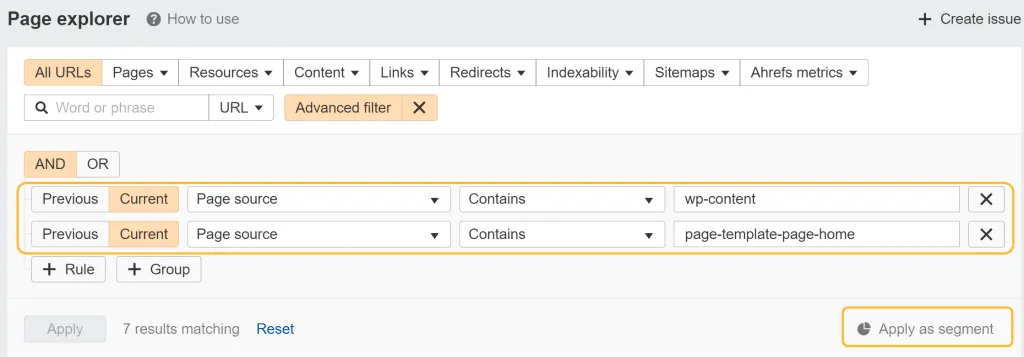
Creating custom segments for each system and page template can help you identify which issues belong to which team and assign fixes to the right people.
In enterprise companies, you’re also likely to deal with a lot of migration projects and mergers, as the company eventually wants to consolidate systems and have consistency in branding. Check out our guides on website migrations and mergers and acquisitions to help with this process.
Getting buy-in for SEO projects
If the company you’re working with doesn’t see the value of SEO, you’ll lose resources and prioritization to whatever the company considers more important. You need to constantly be selling SEO to everyone.
Here are a few ways to do that.
Align your SEO objectives with company goals
You want to do things that have an impact and align with business goals. You should set your SEO objective and key results (OKRs) in a way that you and the business both get what you want.
For example, many businesses have goals to improve revenue from their top products. If you have a project you want to do, like creating some new content around core topics, aligning it to these top products is your best bet at getting buy-in.
Make a business case
The mistake I see many SEOs making with this is that they think things should be done just because they’re a best practice or Google says they should do it. At enterprise scale, trying to do low-level tasks that don’t have much upside potential can waste resources without having much impact.
My best tip is to equate projects to revenue, or as close as you can get to it with some other value metric. For example, I’ve managed to get redirect projects off the ground by assigning a value of $400 for each referring domain recovered.
Here’s how to find those opportunities in Ahrefs:
- Paste your domain into Site Explorer
- Go to the Best by links report
- Add a “404 not found” HTTP response filter
I usually sort this by “Referring domains.”

So for this example, let’s say I do 250 redirects that on average have 10 RDs. That’s 250 x 10 x $400 = $800,000 as a value I can use to pitch for the redirect project. It’s typically a large enough number for the project to get attention and resources.
You may need to do a bit of number crunching or even SEO forecasting, but generally if you can show what work is involved and the expected outcome tied to revenue, you’ll likely be able to make your case for resources.
Work collaboratively with other teams
Making friends through networking and soft skills are important for being successful in an enterprise environment. You need people to like you and to want to work with you. You also need to be a bit opportunistic and be ready to work with them when they’re finally ready to work with you.
One way to get more buy-in is to show people the bigger picture. Communicate with other teams to integrate with them and then show everyone how that leads to more business success.
For example:
- The paid team can expand their advertising based on assets created for organic search and would love to re-market to the people who landed on your organic pages.
- The social team can help promote your content.
- You can syndicate your core content for greater visibility.
- You can capture leads and nurture responses to engage them and guide them toward conversion.
If you can show execs the whole picture of how teams can help each other to grow the business, then you’ll get buy-in and resources easier.
Promote your successes
How are others to know if an SEO project was successful if you don’t show them? Don’t make the mistake of keeping wins to yourself.
Show off your successes in meetings and reports. Give other teams that were involved credit as well. Take that success, and find other teams that want to do the same thing.
Show off your expertise
Don’t think that just because you’re good at your job that you’ll get buy-in. When I worked in enterprise SEO, I initially had trouble getting buy-in at the company, even though I was well-known in the SEO community.
My mistake was not showing people that I was considered a subject matter expert, not just at the company, but in the SEO community in general. Adding a simple email signature that showed some of my writing and speaking engagements really helped me get projects moving.
It helped set me apart and made teams want to work with me, rather than me bothering them about this SEO stuff again. Eventually, I started showing off recent wins with other teams as well.
Democratizing SEO
The more you share with and empower others, the easier your life will be at an enterprise company. A single person only scales so much. Don’t make the mistake of going it alone.
Train people and find your evangelists who believe in and help promote SEO in your enterprise organization. This is how you can scale your impact.
Educate, educate, educate some more
There are many options to bring more awareness and capabilities around SEO to an enterprise organization. For example, you might create standards, a knowledge base of best practices, and stand operating procedures (SOPs) so that people know what they should be doing, why, and how to do it.
You can also offer things like team trainings, workshops, videos, internal courses, or leverage any corporate pushes for education like internal conference series. This will help you find those interested in SEO who can help you evangelize SEO through the organization.
You can also do weekly meetings, office hours, networking events, and ‘lunch and learns’ which are great for training and evangelism. Maybe even start an email newsletter with company and SEO industry updates people would find useful. Any chance to show your expertise will help your enterprise SEO program be successful.
Reporting challenges
Reporting can be a colossal time sink at the enterprise level, but it’s a necessary evil. If you can’t prove your work’s value and how it contributes to the company, nobody will see the importance of SEO.
You’ll create a lot of different SEO reports for a lot of different people. Check out our guide on enterprise SEO reporting to see some of the reports you’ll want to create and the metrics to include in them for different people. It includes things like:
- Figuring out how to equate metrics to money
- Deciding which metrics to report on
- Comparing yourself against competitors
Implementation challenges
Getting changes for SEO in an enterprise environment is often more difficult than it should be.
Legacy systems
I already talked a bit about all the different systems you might encounter in an enterprise environment. A lot of those may be legacy systems, with no funding or support to actually fix things on them. In fact, it may be more expnsive to shut them down than it is to fix them.
The platforms themselves may have major limitations when it comes to SEO. If they’re routed through a CDN, you may be able to use edge workers to fix the issues, sometimes called Edge SEO. Our upcoming Patches system will allow you to fix a lot of issues, even on legacy systems that are often neglected.
Getting legal to sign off
Legal teams can cause headaches for enterprise SEOs. The legal department can kill off content or other initiatives like link building. They may not allow you to do outreach to other companies on behalf of your current company. You’ll have to figure out what you can still implement, without the need for legal approvals.
Collaboration with other teams
I mentioned earlier about working with other teams. Packaging an initiative so that it encourages collaboration means that it is more likely to get adopted. You need to be able to get things done to have an impact.
Prioritization issues
Enterprise companies have a lot of products and services, and enterprise websites usually have a lot of pages. What teams do you work with? What pages do you prioritize improving? These aren’t easy questions.
My best recommendation is to align to company or team goals. Most companies or teams have some products they prioritize or want to improve and that’s where you’re most likely to be able to get buy-in for SEO initiatives. Someone’s bonus is likely tied to the success of these projects, and they’re willing to invest resources to make sure they hit their targets.
You have to prioritize tasks and focus on the most significant issues. I typically use an impact / effort matrix as a visual to help others understand what I consider the most important tasks. Here’s what that looks like:
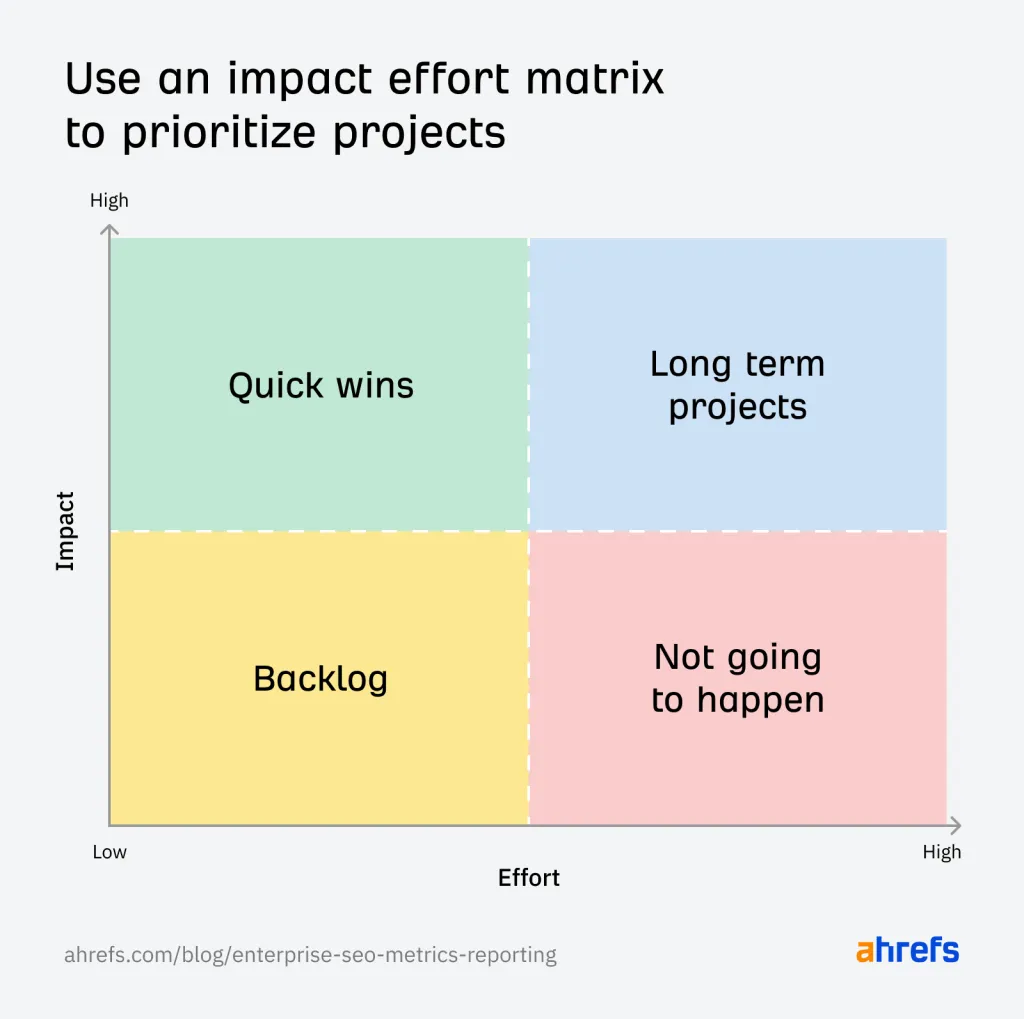
You will likely have to work with any other teams involved for a better effort prediction, but in my experience I’ve found they appreciate it if you take a first pass at estimating the effort involved. Then give them the opportunity to make adjustments based on how much effort they think it will take.
It’s not glamorous, but if you get the SEO basics right at the enterprise level, you’ll likely win. It’s hard to do that at scale, but boring projects = $$$ when it comes to enterprise SEO.
Lack of resources
Even though enterprise SEO budgets look big, resources are never unlimited and there’s a ton to do.
Competing with other teams for resources
Enterprise SEO teams are usually strapped for resources and are in a constant battle with other teams for resources. You have to prove why you should get the resources over everyone else. Show them the value of your work.
Getting more personnel resources
It can be hard to hire the right people and fill the gaps in your team. Sometimes it’s easier to hire an external agency than get another headcount. They typically come out of different parts of the budget, and because it’s easier to fire contractors and agencies, this is often the preferred route to get more personnel.
The way I’ve seen this work best is to have agencies fill in the gaps from your team. Maybe that’s doing more grunt work, specific tasks your team might not have much experience with, or just providing additional resources to enable your team to do more.
They’re also useful as a second set of eyes for identifying problems, opportunities, and providing solutions. You may want your agency partner to do an enterprise SEO audit and present the results. This will often include the same things you and your team have been saying, but coming from an outside service agency it reinforces what you’ve been saying and you’re more likely to get buy-in from leadership.
If you are an enterprise SEO agency, my best piece of advice is to be flexible and do whatever the in-house SEO team needs you to do at the time. Your job is to make the in-house person or team look good, get them promoted, and get them more resources.
Having the right tools
Enterprise SEO tools are expensive and the onboarding process can be a long and difficult process. Getting rid of a bad tool once it’s integrated into your systems can be even harder. Make sure you do your homework and select the right solution for you.
Some enterprise SEO tools have sales teams that promise the world, but the tools disappoint, and no one uses them.
I’ve also seen some companies restrict the usage of outside tools and rely solely on internal tools. This can often be more expensive, even though the tools are often sub-par.
Some popular enterprise SEO tools include:
| Product | Reviews | Pricing | Customers |
|---|---|---|---|
| Ahrefs | G2 4.5Capterra 4.7Gartner 4.5 | Starts at $14,990 / year | 50,000+ |
| Conductor | G2 4.5Capterra 4.4Gartner N/A | No public pricing | 450+ |
| seoClarity | G2 4.5Capterra 4.8Gartner 4.5 | Starts at $3200 / m (1 domain)Starts at $4500 / m (multiple domains) | 3,500+ |
| Botify | G2 4.4Capterra 4.2Gartner N/A | No public pricing | 500+ |
| BrightEdge | G2 4.4Capterra 4.2Gartner 4.2 | No public pricing | 1,700+ |
With so many different tools and so many different needs, how do you know what’s right for you?
I’m obviously biased towards Ahrefs, but we’re really in a league of our own with 44% of the S&P 500 choosing us. Look how we compare to other enterprise SEO tools in the market.

And our organic search share of voice (SoV).
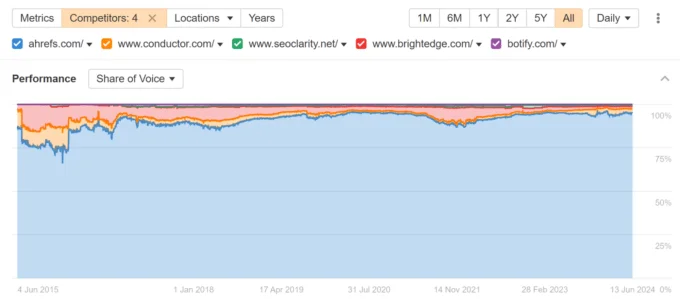
The wrong incentives
One mistake I often see is having the wrong incentives. I’ve been in organizations that were cost recovery, meaning the teams had to charge other teams in order to fund themselves. This led to some poor decisions like charging to put in redirects or adding pages to the CMS.
Things that are done for the good of the company should be centrally funded. Teams shouldn’t have to pay to do the right thing, because many of them won’t have that money in their budgets.
Being reactive, when you should be proactive
Most enterprise SEO teams go through similar organizational challenges as they evolve. This is sometimes referred to as the SEO maturity model.
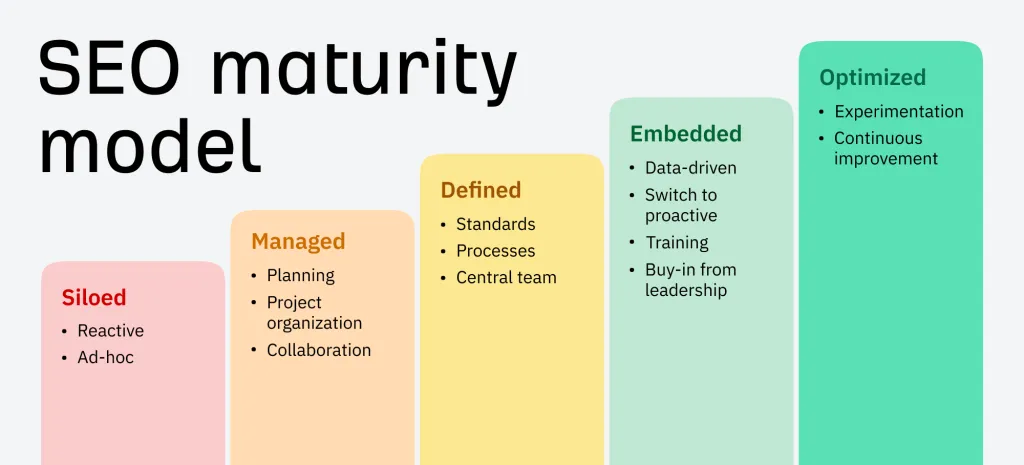
Lots of SEOs start off doing ad-hoc work, but eventually things start to centralize, you create standards and processes (SOPs), and eventually you start to get more buy-in by being more proactive and doing things like training other teams.
A lot of this progression depends on a leader who can be successful, visible, and sell SEO in the organization. They will likely spend as much, or more time promoting successes as they will doing the work.
They may have to create SEO forecasts, have lots of executive meetings to show results, train other teams, create those SOPs, send newsletters to keep others informed, etc.
Education and future-proofing
I talked earlier about educating others on SEO in an enterprise company. Standards, a knowledge base of best practices, and stand operating procedures (SOPs), along with all the trainings and evangelism are more proactive approaches.
Any decisions you make or ways you teach people should be as future-proof as possible. If you’re constantly changing things like the URL structure, there’s going to be a lot of work involved and a lot of risk with very little benefit. If you’re going to do things, try to make sure they will only be done once and not have to be re-done every 6 months.
Critical page and keyword monitoring
Enterprise companies will typically have some kind of top pages or top keywords project. These look at the most critical pages and/or keywords for your business and help you see their performance over time and any trends or issues.
They’re typically used in meetings where there is a quick analysis and an action plan created for any issues or for any successes. You try to look at what worked well so you can replicate it, and try to look for any issues to see what happened.
You can use the Compare pages tab in the Top Pages report in Site Explorer to get this kind of view for your pages. We will be adding one for the Organic Keywords report in the future as well.

Catch technical issues before they launch, or at least faster
The typical crawl cadence I’ve seen for enterprise companies is 1 month. That means it could be nearly a full month before spot issues. There are better ways.
Catch issues before they launch
In some environments, you may be able to set up unit tests to have automated checks for issues before they launch.
You can also use Ahrefs Site Audit to crawl staging and dev environments to check for any issues before they’re launched to the public.
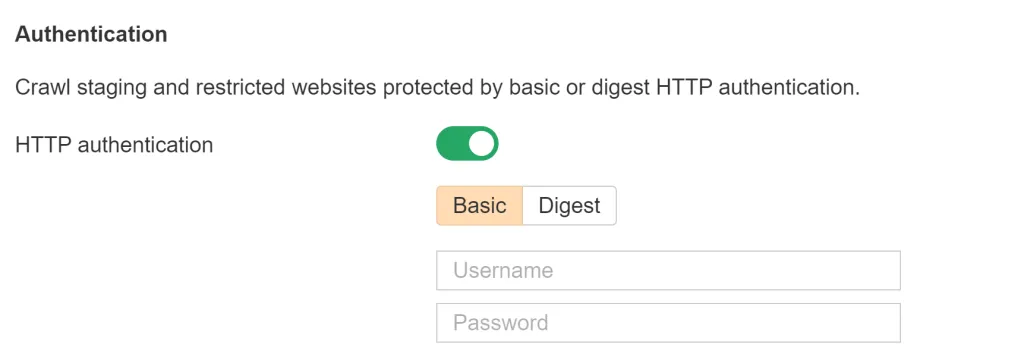
Catch any issues faster with crawl sampling
You don’t always need a full crawl of the website which can take weeks to run on an enterprise site. You just need enough to see if any important changes were made.
You can run Ahrefs’ Site Audit for a custom list of pages daily and get alerted to any changes. Using a sample across different templates or systems, you can find issues faster.
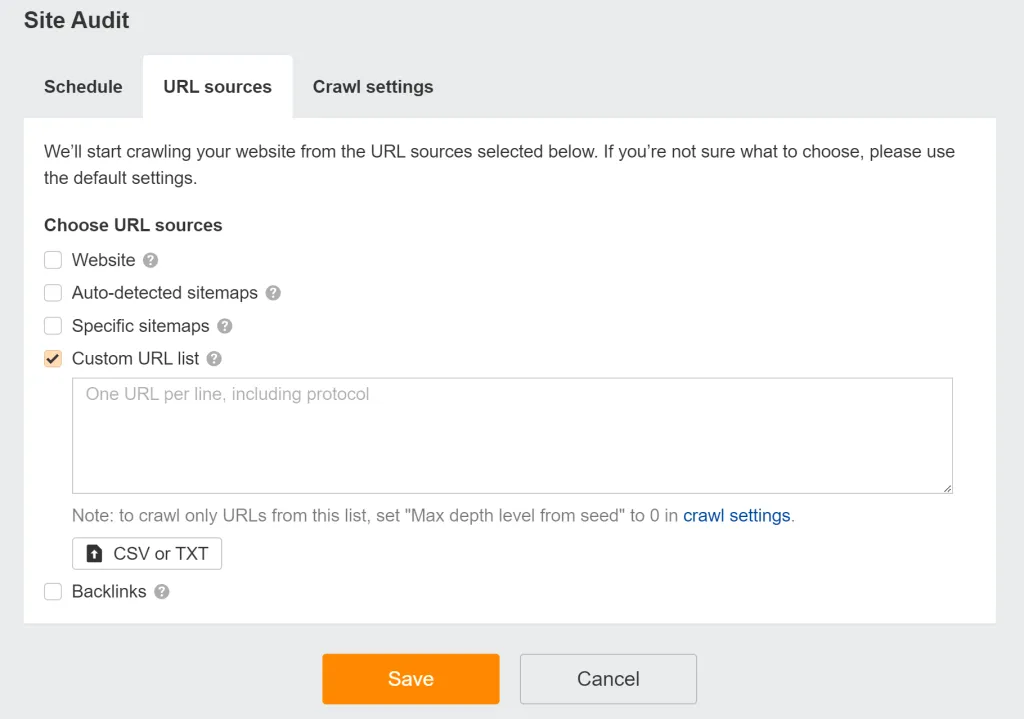
You could also run a smaller crawl on any section that made any new pushes to production.
The fastest way to catch changes – always-on crawling
This is a sneak peak at what we have coming that we’re calling always-on crawling.
The idea is to switch from scheduled crawls, which users tend to schedule weekly or monthly, to a prioritized crawling system that’s always on and notifies users of issues faster.
IndexNow allows us to add a real-time option, which will save resources for our users and ourselves.
For sites using IndexNow and the new always-on option in Site Audit, we’ll be able to notify users of issues shortly after they make updates to their pages.
This is how that will look:
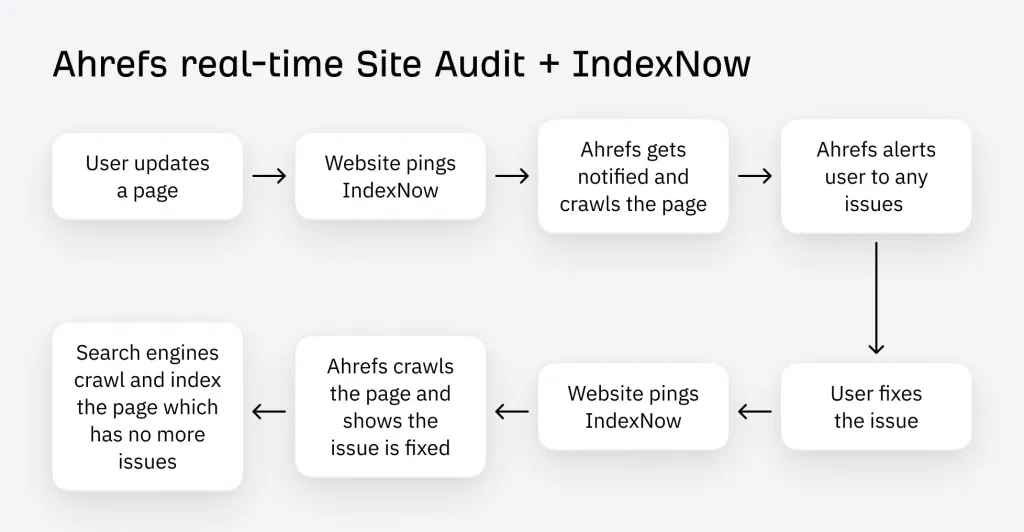
I can’t think of a better system. A practically real-time monitoring and alerting system. As a technical SEO, this is a dream come true for me.
Balancing micro and macro SEO views
One of the mistakes many SEOs make in an enterprise environment is getting caught up in ‘busy work.’ Yes, the more things you’re involved in, the more things you can catch and influence.
I often see SEOs making the mistake of working only on one page at a time. While you need some of this, you run the risk of finding yourself in a position where you’re just ticking off boxes and not strategizing or having a bigger impact. The result is micro gains while still having macro problems.
Enterprise is all about scale, and that includes how you work. You have to focus on what will have the most impact, which means that you need to step away from the busy work and have time to look at the bigger issues and see the bigger picture.
You need a mix of projects in order to be successful. Most companies have some projects around top pages or offerings to make sure those drive more revenue. You might also be tasked with optimizing a certain section of the site, collaborating with specific teams, or working on initiatives that are company-wide but important to SEO.
Focusing only on bottom of funnel content
There are many different types of content you can create, but with limited resources, enterprise companies typically focus on bottom of the funnel content.
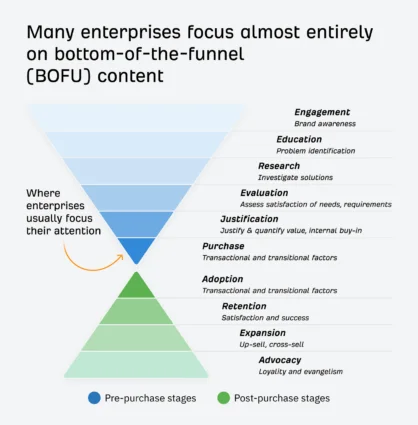
You need to find a way to expand to the top of funnel content such as informational content and videos. This helps to expand your pipeline and gives you the opportunity to be seen as the expert instead of your competitors.
Every touchpoint for a brand is a chance to gain more awareness and credibility, that will eventually lead to conversions. Eventually, you’ll want content targeting every stage of the funnel.
Fierce competition
There’s a lot of money at stake for enterprise companies, and your competitors are also making investments in SEO. You can’t just sit still. You’ll want to monitor what your competitors are doing and use that to your advantage. For example, you can use their wins to show they’re pulling ahead in a certain area, and shift resources or argue for more resources in that area to keep pace with them.
You can use Content Explorer to keep an eye on your competitors’ newly-published pages and pages that they have updated.

You can also create a Portfolio on the Dashboard that includes competing websites, you end up with some pretty interesting views in other reports. For instance, you can get winners and losers for pages and keywords across all of your monitored competitors.
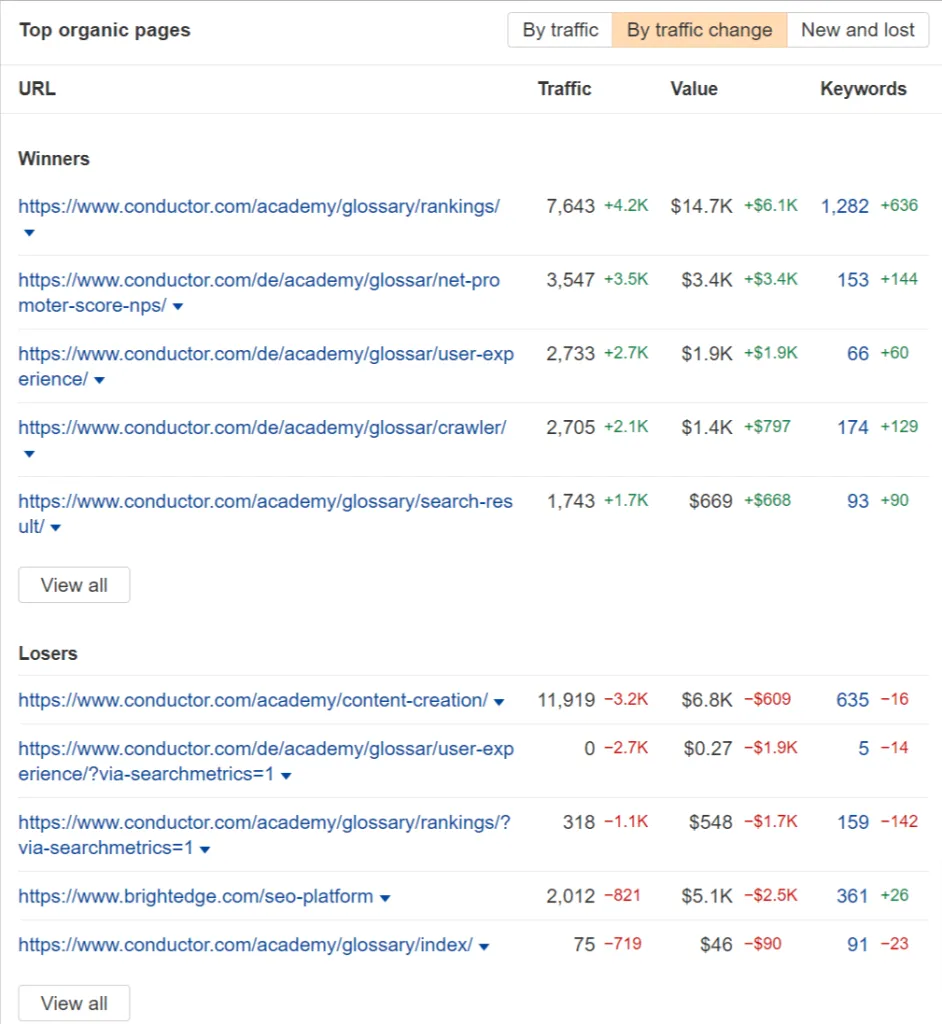
You can also see new and lost pages and keywords to see what is working well for your competitors and what content they’re getting rid of.
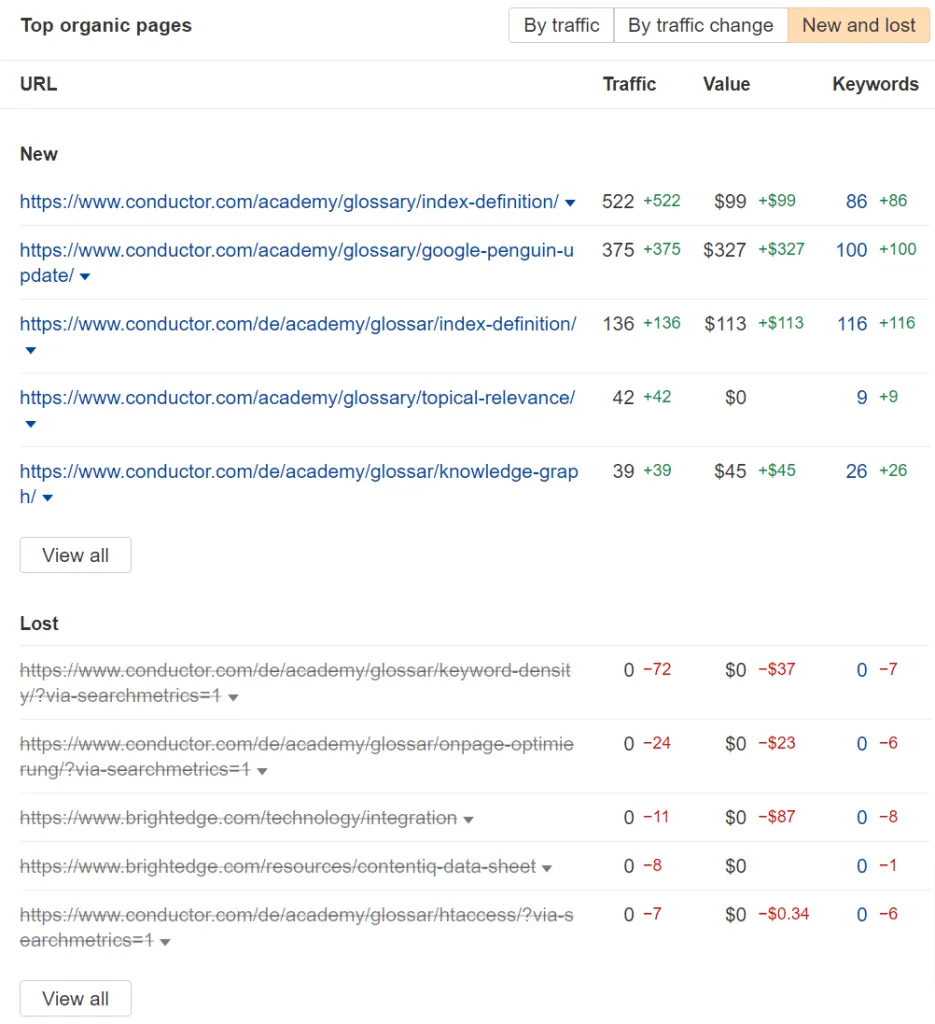
This type of competitive intelligence is great for selling SEO and to pivot on your strategy if necessary. You can also forecast 3rd party metrics, such as those from Ahrefs, to show that more investment is needed to keep pace or surpass a competitor. I show you how in our post on SEO forecasting.
Final thoughts
There’s so much at stake in enterprise SEO and so many opportunities. When a company and its people finally get behind SEO, they can dominate an industry.
Source from Ahrefs
Disclaimer: The information set forth above is provided by ahrefs.com independently of Alibaba.com. Alibaba.com makes no representation and warranties as to the quality and reliability of the seller and products. Alibaba.com expressly disclaims any liability for breaches pertaining to the copyright of content.




